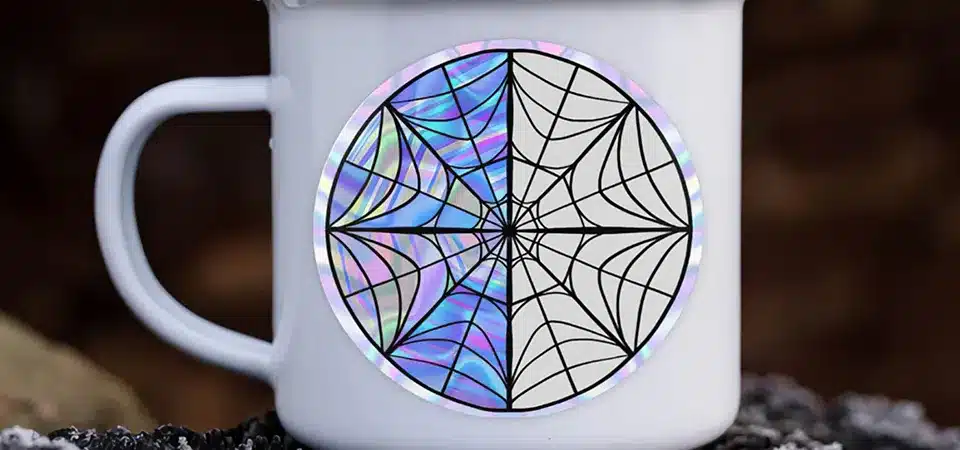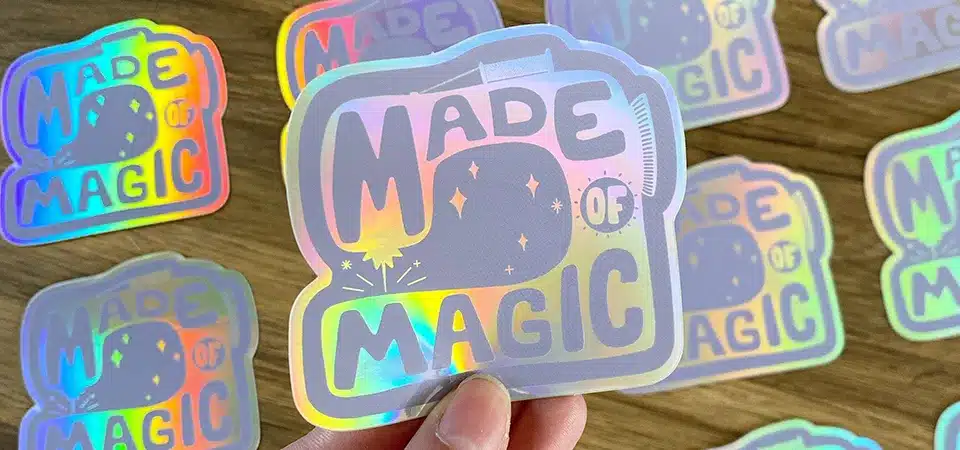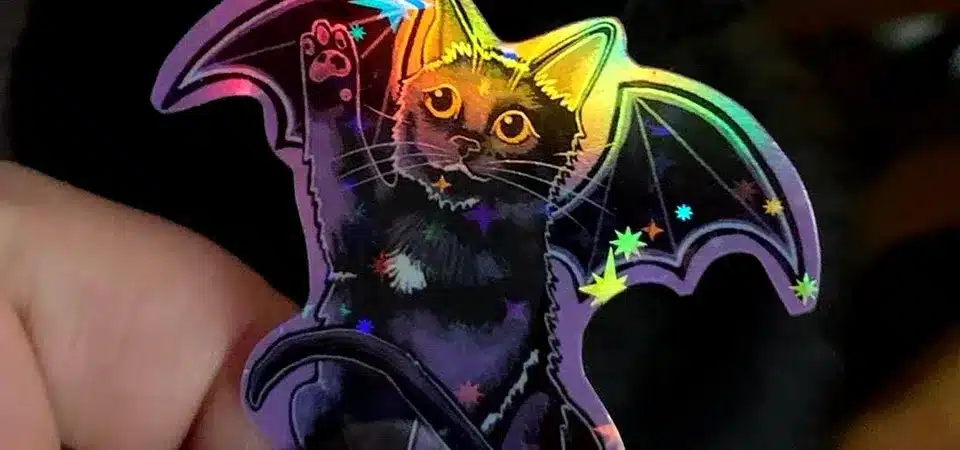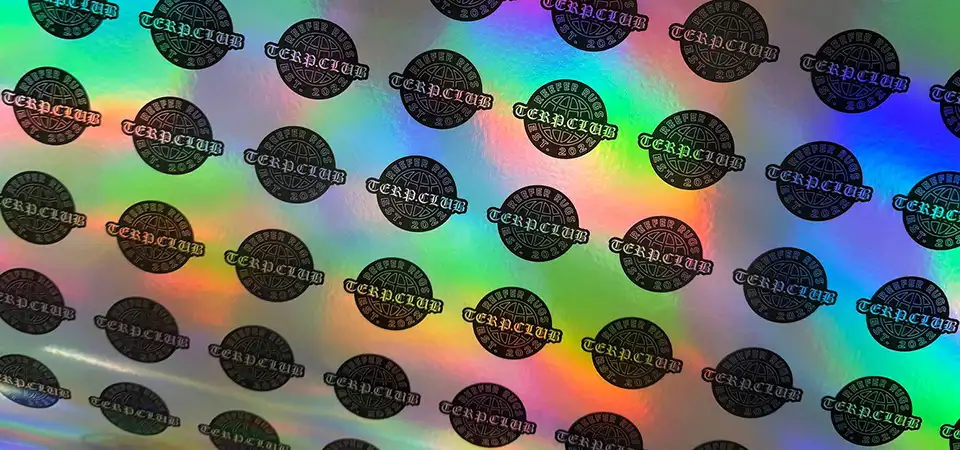You see those amazing, color-shifting holographic stickers and think they must be made with some kind of complex magic. Adding that premium look to your own products feels out of reach.
Holographic stickers are made by printing a design onto a special holographic film. This film, usually made of PET material, has a metallic layer with micro-embossing that diffracts light, creating a rainbow or 3D effect. The sticker is then laminated and die-cut.
As someone who runs a sticker printing business, I handle this amazing material every day. The "holographic" part isn't in the ink; it's in the paper itself. The effect is created by an incredibly thin, metalized layer that's embossed with a microscopic pattern. When light hits it, the pattern acts like a prism, splitting the light into a rainbow of colors. It’s a fascinating process that combines physics and art. In this guide, I'll pull back the curtain and show you exactly how these eye-catching stickers go from a digital file to a finished product, including how security holograms are different.
What is a holographic sticker?
You've seen them on products and packaging, shimmering with color. But you're not exactly sure what makes them different from a regular shiny or metallic sticker.
A holographic sticker is a label printed on a special vinyl or film with a micro-embossed metallic layer. This surface diffracts white light into a full spectrum of colors, creating a dynamic, rainbow-like effect that shifts with the viewing angle.
The key difference between a holographic sticker and a simple metallic one is that holographic material actively plays with light. A silver metallic sticker is just reflective, like a mirror. A holographic sticker, however, has a microscopically textured surface. Think of it like the back of a CD or DVD. Those tiny grooves are what separate light into different colors.
When we talk about holographic stickers in the printing world, we're usually referring to this rainbow effect. It's not a true 3D hologram like you might see in a science fiction movie. Instead, it's an amazing optical effect created by the material itself. We print your design right on top of this material. The parts of your design that are transparent or have no ink will show the full rainbow effect, while the parts with ink will cover it. This allows for some really cool design possibilities, where you can use the holographic effect as part of your art.
How are holographic stickers made?
You know what they are, but the actual step-by-step process seems like a secret. You wonder how a design file becomes a physical, color-shifting sticker you can hold.
First, we print your design onto a sheet of holographic film using UV, eco-solvent, or screen printing. Then, we apply a clear protective laminate. Finally, we use a die-cutting machine to precisely cut the sticker into its final shape.
The production process is a careful, multi-step system designed to create a durable and vibrant product. As a printing expert, I oversee this process from start to finish. Let's break it down into the core stages.
The Three Main Stages of Production
-
Printing: This is where your digital design becomes a physical print. We take your artwork and print it directly onto the surface of the holographic vinyl sheets. We use professional-grade inks that adhere properly to the slick, non-porous material. The choice of printing method depends on the order volume and design complexity.
- Digital Printing (UV or Eco-Solvent): Perfect for small to medium runs and complex, full-color designs. UV printing is especially good as the ink is cured instantly by ultraviolet light, making it very durable.
- Screen Printing: Better for large quantities of simple designs with one or two solid colors. It lays down a thick, very durable layer of ink.
-
Lamination: After printing, the ink is dry but still exposed. To protect it, we apply a thin, clear layer of plastic film over the entire sheet. This lamination is crucial. It makes the sticker waterproof, scratch-resistant, and protects it from fading in the sun (UV protection).
-
Die-Cutting: The final step is cutting the stickers out from the sheet. We use a digital plotter or a steel die to cut precisely around your design, through the laminate and the holographic vinyl, but not through the paper backing. This is called a "die cut," and it's what allows you to easily peel your custom-shaped sticker off the backing.
Can you print on holographic vinyl?
You love the holographic effect but have a specific color palette for your brand. You're worried that printing on the material will mess up your colors or just not work at all.
Yes, you can absolutely print on holographic vinyl. We use specialized UV or eco-solvent inks that adhere to the slick surface. Printed colors will appear metallic, while unprinted areas will show the full rainbow holographic effect.
This is one of the most common questions I get, and the answer is a big yes! Printing on holographic vinyl is what we do. The process is a bit different from printing on regular paper. The vinyl surface is not porous like paper, so we can't use standard water-based inks; they would just bead up and smudge. We have to use professional inks that are designed to bond with plastic surfaces.
The cool part is how the printed colors interact with the holographic material underneath. If you print a yellow ink, for example, it won't be a flat yellow. It will be a metallic, shimmery yellow that catches the light. Black ink looks incredibly deep and rich, creating a stark contrast against the rainbow effect.
The most effective holographic designs use this interaction as a feature. By leaving parts of your design transparent (with no ink), you let the holographic material shine through at full strength. This contrast between the printed colors and the raw holographic effect is what makes these stickers so dynamic and eye-catching. You have complete control over what parts of your design are holographic and what parts are colored.
How is holographic vinyl made?
You're curious about the material itself. You understand it creates a rainbow effect, but how is that effect physically embedded into a simple sheet of plastic film?
Holographic vinyl is made by embossing a microscopic diffraction pattern onto a thin layer of aluminum coated onto a PET film. This embossed pattern diffracts light, splitting it into its component colors, much like a prism.
The creation of the vinyl itself is a highly technical manufacturing process. I find it fascinating because it's where pure physics meets mass production. It starts with creating a "master hologram."
First, an extremely high-powered laser is used to etch a microscopic pattern, called an interference pattern, onto a light-sensitive glass plate. This master plate contains the original holographic information. This master is then used to create metal stamping plates.
Next, a thin roll of plastic film, usually PET (a type of polyester), is coated with a microscopically thin layer of aluminum in a vacuum chamber. This gives it the shiny, metallic look.
Finally, the aluminized film is passed through high-pressure rollers that have the holographic pattern on them. These rollers press the pattern from the metal stamping plates into the aluminum layer. This embossing process is what creates the millions of tiny grooves and ridges that will diffract light. Once the pattern is embossed, an adhesive layer and a paper backing are applied to the other side, and you have a finished roll of holographic vinyl, ready for us to print on.
What finish do your holographic stickers have?
You're ready to order but need to know the final look and feel. Will the sticker be shiny and reflective, or will it have a more subdued, modern appearance?
By default, our holographic stickers have a high-gloss finish. This is because the base holographic material is shiny, and the protective overlaminate we use is also glossy, which enhances the rainbow effect and makes colors pop.
The standard finish for a holographic sticker is glossy. There are two main reasons for this. First, the holographic film itself is inherently shiny due to its metalized layer. Second, the clear protective overlaminate we apply after printing is also glossy. This combination creates a super vibrant, high-impact look that makes the holographic effect as bright and dynamic as possible. The gloss finish reflects a lot of light, which maximizes the rainbow shimmer.
However, we can also create a matte holographic sticker. For this, we use a special matte overlaminate instead of a glossy one. This gives the sticker a very unique, frosted, and non-reflective finish. The holographic effect is still visible underneath, but it's much softer and more subtle. It's a very modern and premium look.
Here is a quick comparison:
| Finish | Look & Feel | Holographic Effect | Best For |
|---|---|---|---|
| Gloss | Shiny, vibrant, reflective | Bright, intense, dynamic | Eye-catching logos, energetic brands, anything that needs to POP |
| Matte | Frosted, soft, non-glare | Subtle, soft, diffused | Elegant branding, sophisticated designs, a modern and understated look |
Most of our customers, about 95%, choose the standard gloss finish because they want the maximum holographic impact. But the matte option is fantastic for brands that want something a little different and more refined.
How are security hologram stickers different?
You've seen holograms on credit cards and software boxes and they look different. You wonder if those are made the same way as the decorative rainbow stickers you see on laptops.
Security holograms use custom, laser-embossed optical patterns that are nearly impossible to duplicate, unlike standard holographic vinyl which uses repeating, generic patterns. They are made for anti-counterfeiting and often include tamper-evident features.
This is a critical distinction. While both decorative and security holograms use the same basic principle of light diffraction, their purpose and creation are completely different. Decorative holographic stickers are all about aesthetics. Security holograms are all about authentication and anti-counterfeiting.
What is a security hologram?
A security hologram is an advanced optical device created with specialized laser technology. It contains microscopic images, patterns, or information that cannot be created or copied with standard printing or scanning equipment. They often have multiple layers of security features. These can include:
- 2D/3D Effects: Where the image appears to have depth and float at different levels.
- Kinetic Effects: Patterns that appear to move or animate as you tilt the sticker.
- Microtext: Tiny text that is only visible under magnification.
- Covert Features: Hidden images or information that can only be seen with a special laser reader.
How are security hologram stickers made?
Making a true security hologram is a much more complex and expensive process. It requires a dedicated holography lab with vibration-proof tables and high-powered lasers. The artwork is broken down into multiple layers, and each layer is recorded individually by lasers to create the master hologram. This master is a one-of-a-kind original. Because this process is so difficult and costly, it acts as a powerful deterrent to counterfeiters. Often, these stickers are also combined with other security features, like unique serial numbering or a tamper-evident adhesive that leaves behind a "VOID" pattern if someone tries to peel it off.
Conclusion
Holographic stickers are made by printing on and laminating a special light-diffracting film. This process creates a stunning, durable product for branding, while security holograms use advanced, custom techniques for counterfeit protection.














